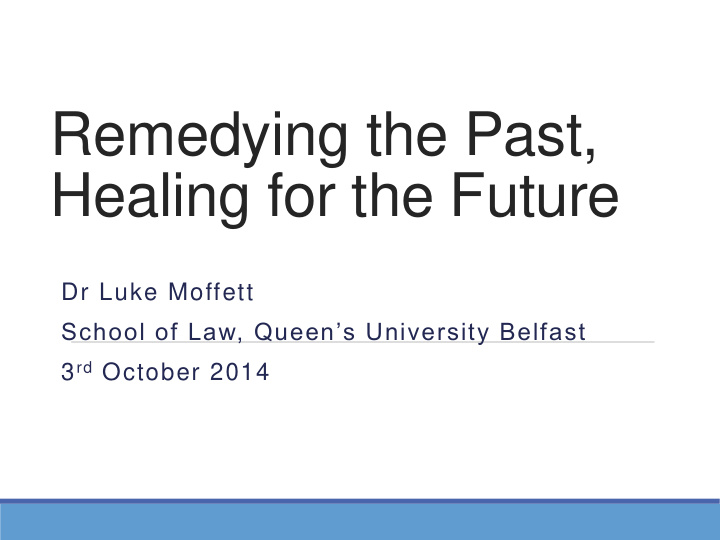



Remedying the Past, Healing for the Future Dr Luke Moffett School of Law, Queen’s University Belfast 3 rd October 2014
Overview • What are remedies? • What are reparations? • Types of reparations • Who is eligible? • Who is responsible for reparations? • Past Northern Ireland proposals
What are remedies? • Equal and effective access to justice mechanisms to receive redress Justice Truth Reparations Remedy
What are reparations? o Reparations are victim-centred measures of redress to repair the harm caused o Reparations are meant to respond to the needs of victims, alleviate suffering, and prevent violence recurring In comparison to other processes: ◦ Prosecutions focus on the acts of perpetrators ◦ Truth commissions try to uncover the truth for the whole of society o Reparations work best when used with truth commissions and judicial processes
Types of reparations Principles 19-23, UN Basic Principles and Guidelines on the Right to a Remedy and Reparation: 1. Restitution 2. Compensation 3. Rehabilitation 4. Satisfaction 5. Guarantees of non-repetition Ordered together to holistically remedy victims’ harm
Restitution • Return of property/restore rights
German reparation pension to University scholarships Holocaust survivors Compensation • Lump sums • Annual/monthly pensions
Rwandan genocide survivor support service (NGO) Rehabilitation • Medical and psychological care • Education and vocational support • Legal and social services
The Eye that Cries memorial, Peru Lukodi Massacre Memorial, Uganda Measures of satisfaction • Memorials • Public apologies, acknowledgement of responsibility and victims’ dignity • Recovery of those disappeared • Truth recovery
Guarantees of non-repetition • Prevent future violations • Civilian control over security forces • Human rights promotion and protection
• Medical costs Material • Return of property Reparations • Loss of earnings • Public apologies Symbolic • Acknowledgement of responsibility Reparations • A • Shared memorials • Material reparations aim to provide reimbursement of the economic cost of a crime or violation • Symbolic reparations serve to publicly acknowledge victims’ suffering and dignity • Material and symbolic reparations are usually ordered both together to alleviate the costs of harm caused to victim, and to publicly acknowledge the wrongfulness of victims’ suffering • Reparations can be awarded to individuals or collectively to groups or communities who have been harmed, such as child soldiers.
Who is eligible? o Victims, their family members and dependents ◦ All those who suffer as a result of a violence act ◦ Victim focused – to remedy suffering, no matter the action of the victim or identification of the perpetrator (non-discriminatory) ◦ Gender and trans-generational impact o Individuals who intervened/witnessed, or assisted victims (carers) o Victims entitled to reparations even if the perpetrator is not identified or prosecuted o All victims? ◦ A number of countries focus on those most vulnerable and who continue to suffer ◦ Such as those individuals who were killed, disappeared, tortured or injured ◦ Reparations are not meant to enrich or impoverish victims
Who is responsible for reparations? o The state is responsible for acts or failures to act by its own agents that resulted in death or serious injury o Corporate responsibility of paramilitary groups o Apologies/acknowledgement of responsibility o Assist recovery of those disappeared o Contribute to truth recovery processes o Individual perpetrators can be held responsible ◦ If perpetrator is unknown or penniless, state is responsible for reparations ◦ Penniless perpetrators can contribute to measures of satisfaction such as apologies and acknowledgement of responsibility State should establish a reparation mechanism for all victims of serious violence
Past Northern Ireland Proposals Consultative Group on the Past (2009) • ‘Recognition payment’ - £12,000 to those killed - ‘ex - gratia’ i.e. without acknowledging responsibility - Excluded those injured • A day of reflection (21 st June) • A shared memorial Haass- O’Sullivan All -Party Talks (2013) • Continuation of Victim and Survivor Service • Mental Trauma Service • Those responsible to acknowledge the wrongfulness of their actions ‘and include a sincere expression of remorse for pain and injury caused. ’
Reparations three components: 1.Acknowledgement ◦ Public recognition of victims’ suffering 2.Responsibility ◦ Made by those responsible, such as the state, paramilitary organisations, or individuals ◦ Ultimately the state is responsible for establishing reparation mechanisms 3.Remedy ◦ Provide appropriate remedies to repair harm caused: ◦ Materials forms: compensation, restitution, rehabilitation, ◦ Symbolic: measures of satisfaction and guarantees of non recurrence
More information on reparations UN Basic Principles and Guidelines on the Right to a Remedy and Reparation for Victims of Gross Violations of International Human Rights Law and Serious Violations of International Humanitarian Law (2005) – inside your conference pack
Recommend
More recommend